 |
||
|
 |
Year 5 Issue 3 April 2006 | |||
| Platinum dreams - an encounter with tomorrow's classics | |||||||||||||||||
Platinum is regarded on the contemporary jewellery scene as the epitome of all that is special. But this was not always the case. Only after the founding of Platinum Guild International (PGI) Germany in 1976 did consumers there begin to take notice of its unique attributes. Platinum has evolved during the past thirty years from a material for avant-garde designers to the embodiment of elegance and genuine values. There was no turning back after people recognized how special platinum truly is. In the 18th century, the veil of mystery lifted around platinum. It was recognized as the most sublime of all metals. Because platinum was so little known as a jewellery metal, it was not until the early 20th century that it celebrated its first gala debuts. Louis Cartier elevated it into the jewellery heavens. But platinum slipped into oblivion as the Art Deco era neared its end. War raged, and platinum's unique properties were forgotten. This changed with the founding of PGI (Germany) in 1976, an organization formed by a consortium of platinum producers, jewellery designers and jewellers with a goal to return platinum to its rightful place in the limelight of public attention. German, Austrian and Swiss jewellery makers responded enthusiastically to platinum's rediscovery. Niessing pioneered the articulation of platinum's characteristic look by giving a matte finish to the surfaces of platinum jewellery, and found an appropriately visible form for platinum's incomparable attributes, inventing the Niessing Spannring® in 1979. This modern jewellery classic relies solely on the inherent tension in the ring's band to firmly hold a diamond. |
|||||||||||||||||
|
|||||||||||||||||
Creations
like this one made a formative impression on the jewellery landscape.
Platinum inspired designers and manufacturers to further develop a formal
idiom appropriate for the contemporary era. Creative minds initially focused
on the sleekly geometrical basic forms which came to typify platinum jewellery
- it soon epitomized minimalist design. Designer, Georg Bunz made another
important contribution, discovering platinum in his quest for a timeless
style. He has cultivated it ever since the founding of his atelier in
1975. The intimate liaison between platinum and purism dominated the 1980s, the "decade of design." The art of dispensing with inessentials gained a strong foothold in the world of jewellery design. Platinum was no longer regarded merely as a substrate to carry valuable gems - the beauty of metal itself came to occupy the focal point. In the 1990s, progress culminated in serener, more voluminous and more luxurious designs. The purist approach to design underwent variation - soft, romantic elements augmented and enriched often generously proportioned forms. These have now been joined by a classically elegant element and by the quest for authenticity and the trend toward genuineness, nobleness and purity. |
|||||||||||||||||
Platinum
has now become a favourite material for goldsmiths and jewellery makers.
Trendsetters in the world of contemporary jewellery also appreciate platinum
as a perfect partner. Renowned for his extravagant and lavishly colourful
designs, Georg Spreng, said, "It is an absolutely timeless metal
that will continue to weave its enchanting spell for many years to come." With a combination of savvy design and high material value, platinum is the ultimate jewellery metal with a breathtaking diversity - a glamorous partner for coloured gemstones, diamonds and pearls. Formerly only a privileged metal for unconventional creations, platinum has now become the preferred material for engagement and wedding rings. Today's platinum is an encounter with tomorrow's classics, www.preciousplatinum.com. |
|||||||||||||||||
| KARA designer jewellery show set for Paris | |||||||||||||||||
|
|||||||||||||||||
|
|||||||||||||||||
| The Truth abouf Turquoise... A brief History | |||||||||||||||||
Turquoise is found in many countries, but is most commonly associated with the Southwest US, China, and Iran, which is home to some of the finest quality Turquoise. First mined on the Sinai Peninsula (part of modern Israel) and transported to Western Europe through Turkey, Tur-quoise got its' name from Europeans who mistakenly thought that it was found in Turkey. The name comes from the medieval French word for Turkish, "turqueise." 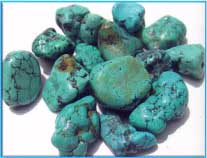 Much older than Native American civilizations with whom
the stone is most commonly associated, Turquoise was used in ancient Egypt,
ancient Eastern and ancient Middle Eastern civilizations. Native Americans
had as many different words for turquoise as there were languages spo-ken.
However, many of the words translated into English as the "skystone,"
evoking the sky-blue shade of the stone most commonly found. They had
been working in turquoise mines with stone mauls and antler picks for
centuries before highest the arrival of the Europeans. Most often, in
the Southwest, the stone was carved into beads (heishi), fetishes, or
over-laid onto wood, bone, or shell. The Spanish brought to the Southwest
their knowledge of silver and silversmithing. This was combined with Native
American lapidary technology to produce a turquoise jewelry tradition
that lives today. Native American jewelry, whether tradition or complementary,
is the harmonious melding of seperate but complementary art forms.
Much older than Native American civilizations with whom
the stone is most commonly associated, Turquoise was used in ancient Egypt,
ancient Eastern and ancient Middle Eastern civilizations. Native Americans
had as many different words for turquoise as there were languages spo-ken.
However, many of the words translated into English as the "skystone,"
evoking the sky-blue shade of the stone most commonly found. They had
been working in turquoise mines with stone mauls and antler picks for
centuries before highest the arrival of the Europeans. Most often, in
the Southwest, the stone was carved into beads (heishi), fetishes, or
over-laid onto wood, bone, or shell. The Spanish brought to the Southwest
their knowledge of silver and silversmithing. This was combined with Native
American lapidary technology to produce a turquoise jewelry tradition
that lives today. Native American jewelry, whether tradition or complementary,
is the harmonious melding of seperate but complementary art forms.What is turquoise? Turquoise stone is a hydrous basic phosphate of copper and aluminum which is formed as water trickles through a host stone for about 30 million years, gradually leaving a deposit. - if the mjx has more copper, the turquoise will be colored in the blue range; if more aluminum, in the green to white range. The addition of zinc yields a yellow-green color and hardens the stone even more. The yellow-green color has been found so far only in Carico Lake, Damali, and Orville Jack turquoise from Nevada. |
|||||||||||||||||
Color
of turquoise? Turquoise, like most stones, has a wide range of color and quality. It ranges from a deep sky blue or Robin's Egg Blue to Green, and yellowish green,and brown. While the bluest stones with the least webbing are usually the highest valued, individual taste will rank stones differently. Some prefer the stone to be blue with dark thick green with thin lines, reminiscent of webbing; still others prefer the earthy tones, lime green and earthen brown. Because Turquoise is formed through the oxidation of copper and Iron it is a relatively porous stone that should be carefully cleaned. Clean the stone with soap and warm water only. 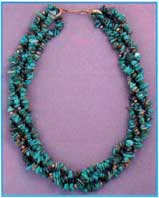 What is the "matrix" in turquoise? Other colors that appear in a turquoise stone come from the host stone that the turquoise formed in, and are called "matrix." A black matrix is usually from iron pyrite; a gold-brown matrix from iron oxide, and a yellow to brown matrix from rhyolite. Matrix that is thin and evenly spaced over the surface of the stone is commonly known as "spider web" matrix. Spider web matrix usually enhances the col-lectibility and value of turquoise. How is turquoise mined today? Most turquoise mining operations are very small, some as small as one family. The mining sites, of course, are very isolated, and living and working conditions are primitive and sometimes dangerous. One advantage 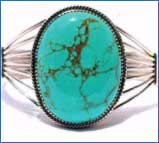 modern
miners have over previous miners, who worked with hand tools, is a gas
generator. To this the miner hooks up a saw with a diamond cutting blade
and a machine with a grinding wheel. Using water to cool the cutting blade,
the miner cuts away chunks of host stone to get to thetur-I quoise vein.
Refined : extraction and shaping of the turquoise is done with the grinding
wheel. Final shaping is done arid the piece is backed by epoxy to form
a cabo-chon, a cut and polished stone ready for setting. Theepoxy backing
helps to protect the stone against chipping and breaking when it is set
in silver jewelry and worn. This is all very labor intensive and time
consuming. Native American artisans may buy turquoise cabochons directly
from miners, but most buy from jewelry supply stores or trading posts. modern
miners have over previous miners, who worked with hand tools, is a gas
generator. To this the miner hooks up a saw with a diamond cutting blade
and a machine with a grinding wheel. Using water to cool the cutting blade,
the miner cuts away chunks of host stone to get to thetur-I quoise vein.
Refined : extraction and shaping of the turquoise is done with the grinding
wheel. Final shaping is done arid the piece is backed by epoxy to form
a cabo-chon, a cut and polished stone ready for setting. Theepoxy backing
helps to protect the stone against chipping and breaking when it is set
in silver jewelry and worn. This is all very labor intensive and time
consuming. Native American artisans may buy turquoise cabochons directly
from miners, but most buy from jewelry supply stores or trading posts. |
|||||||||||||||||
| What are the different
"kinds" or grades of turquoise?
1. NATURAL turquoise means a stone with no alteration
to its composition. Such stones are merely polished and cut into shapes
before being mounted in jewelry. Natural turquoise remains porous, as
all natural stone is to varying degrees, and may tend to |
|||||||||||||||||
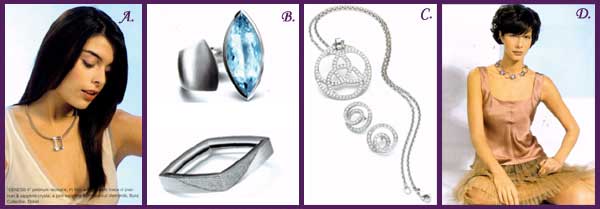

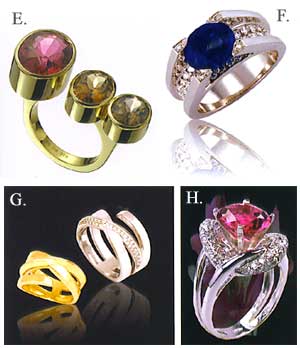
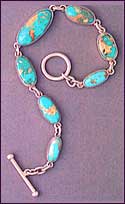 change
color over time as it is worn and handled.
change
color over time as it is worn and handled.